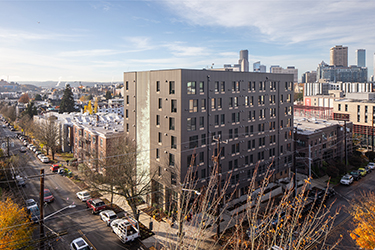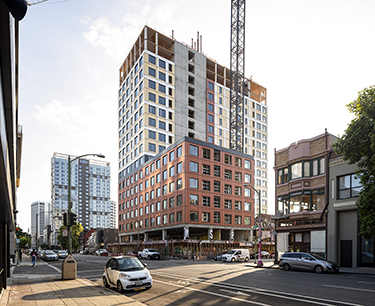|
Subscribe / Renew |
|
|
Contact Us |
|
| ► Subscribe to our Free Weekly Newsletter | |
| home | Welcome, sign in or click here to subscribe. | login |
Architecture & Engineering
| |
April 15, 2024
Study: Cost of hybrid mass timber towers now nearly the same as concrete high-rises
According to a new study co-authored by PCL Construction, DCI Engineers, and Weber Thompson, which all have offices and are active in the Seattle area, building a hybrid mass timber high-rise is now nearly as cost-effective as building a comparable concrete tower.
This was the finding of the recently released “Hybrid Tall Timber: Mass Timber Residential High-Rise Study” that examined the decreasing costs of mass timber construction and its potential to expand residential space in densely populated urban regions.
The study found that when factoring in cost savings from the reduced schedules associated with using prefabricated mass timber, combined with an improved material supply chain, an 18-story residential high-rise built using a hybrid of mass timber and concrete could cost as low as $74.45 per square foot to build.
That is slightly more expensive than the cost of $71.09 per square foot to build a concrete building of the same size, but the authors suggest that the competitive price may influence developers to think twice about the materials used in their next project.
The study also highlights some unique benefits of building with mass timber that could persuade developers to opt for hybrid structures as a way to differentiate their product in a competitive leasing market.
Those include reductions in embodied carbon and biophilic benefits.
When it comes to embodied carbon emissions, the report found that an 18-story hybrid building built of concrete and mass timber could store up to 3,350 metric tons of CO2e (carbon dioxide equivalent) throughout the building's useful life; the equivalent to the carbon sequestered by 4,000 acres of U.S. forests in one year or eliminating 745 gasoline-powered passenger vehicles from the road for one year. This finding is particularly relevant as the push for low-carbon construction is increasingly legislated via new carbon taxes and mandates.
The report concludes that mass timber construction provides an alternative that can be cost-competitive or more economical under the right circumstances — which might pave the way for the construction of more buildings in the intermediate tower height zone, and potentially increase housing density that would help battle a lack of housing in cities like Seattle.
“This could be great news for both the environment and renters in the Seattle area,” the authors say.
Seattle already has a midrise hybrid steel/mass timber multifamily building, the eight-story Heartwood that opened in November. Hybrid mass timber structures are also becoming a popular choice for commercial/education buildings, like the newly finished Northlake Commons office/retail building at 3800 Latona Ave. N.E.
A high-rise mass timber hybrid project however is yet to break ground here.
A copy of the full report can be downloaded at https://tinyurl.com/TallHybridMassTimberStudy.




